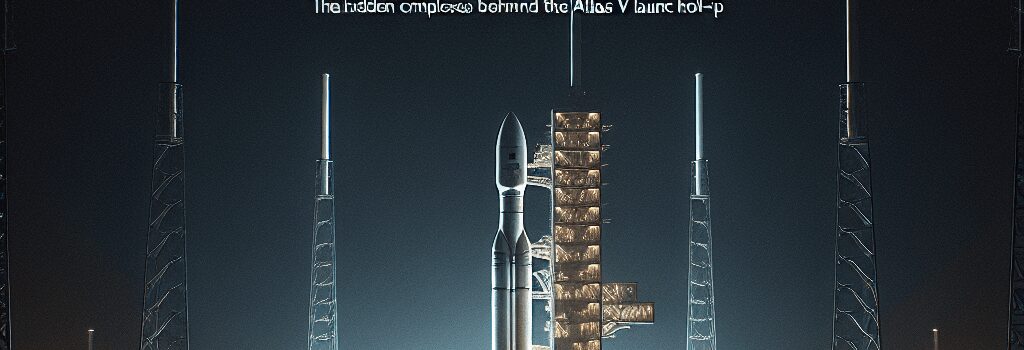Decoding the Delay: The Hidden Complexities Behind the Atlas V Launch Hold-Up

The Space Force’s recent decision to delay the next Atlas V launch—intended to deploy a full load of 27 satellites for Amazon’s Kuiper internet megaconstellation—has raised eyebrows and ignited debates within the aerospace community. While weather-related issues are par for the course at Cape Canaveral, this extended turnaround came with a cryptic message from United Launch Alliance’s (ULA) operations, hinting at underlying technical and operational complexities.
Launch Preparations and the Unexpected Turn
The Atlas V rocket was meticulously positioned on the launch pad with the assistance of trackmobile railcar movers, fully loaded with the inaugural satellites for Amazon’s ambitious Project Kuiper. Just minutes before launch, however, inclement weather forced engineers to scrub the countdown on April 9. Although such delays are not unusual, ULA’s launch director, Eric Richards, instructed his team to prepare for an “extended turnaround,” postponing the attempt by more than 24 hours.
Scheduling Conflicts and Inter-Agency Coordination
Initially, the delay was believed to be related to scheduling conflicts with SpaceX. The Eastern Range—managed by the Space Force—operates on a first-come, first-served basis. With SpaceX set to launch a Starlink mission around the same window (which was itself delayed from April 10 to April 12), ULA’s Atlas V mission found itself sidelined. Notably, while SpaceX’s Falcon 9 employs a modern automated flight termination system, ULA’s Atlas V utilizes a human-in-the-loop range safety system that demands additional technical coordination and personnel. This difference not only affects launch timings but also dictates how conflicts are resolved on a busy range.
Technical Details and Safety Protocols
Sources within ULA have confirmed that there were no major mechanical or payload issues. As a company spokesperson stated, “The rocket and payload are healthy,” suggesting that the extended delay was not due to any critical technical malfunctions. Instead, the Atlas V’s reliance on an older safety system—which requires manual oversight and additional specialized equipment—has contributed to the cautious approach adopted by launch controllers. This legacy system, while robust, contrasts with more agile modern designs and highlights the growing pains as launch cadence increases.
Range Infrastructure and Increased Launch Cadence
The Eastern Range spans an astonishing 15 million square miles, including ground stations and tracking assets spread from Florida to Bermuda and Ascension Island. With 93 launches recorded last year—a stark contrast to the sparse schedule of the early 2000s—the infrastructure is under constant pressure. Traditionally, Cape Canaveral would shut down for maintenance and upgrades periodically, but with the current increased frequency, the Space Force has adopted a near air-traffic control model, balancing maintenance with rapid mission turnarounds.
Deeper Analysis: Geopolitical and Strategic Considerations
Beyond the technical and scheduling aspects, industry experts speculate that the extended delay could stem from broader strategic priorities. One theory points toward potential undisclosed military exercises or tests, such as submarine-launched Trident missile drills, which are known to occur off the Florida coast. Although such tests typically come with public safety advisories, the absence of any formal notice fuels speculation of high-level, classified activities influencing the launch schedule. This interplay between national security and commercial space operations further complicates range scheduling at Cape Canaveral.
Modernization of Spaceports and Future Operational Models
The evolving landscape at Cape Canaveral is prompting significant long-term changes. With legislative support such as the National Defense Authorization Act for fiscal year 2024, the Space Force now has the authority to charge indirect fees to commercial launch providers. This funding model is intended to modernize critical infrastructure—improving roads, electrical and water utilities, and base security—to better support a high cadence of launches. Industry leaders believe that these improvements will eventually facilitate near on-demand launch capabilities, making spaceport operations resemble modern airport logistics.
Expert Opinions and Industry Perspectives
Industry figures such as Tory Bruno, ULA’s CEO, have pointed to the Space Force as the primary source for scheduling clarifications, reflecting the opaque nature of current decisions. Experts in aerospace engineering are advocating for an update of legacy range safety systems to match the rapid advancements in commercial launch technology. “Every delay is a critical learning opportunity,” commented one aerospace systems analyst. “Understanding the constraints of older systems while integrating new safety protocols is essential as we push towards a future with significantly higher launch frequencies.”
Conclusion: Navigating the Future of Space Operations
While the secret behind the Atlas V delay remains partially shrouded, this incident underscores the immense complexity of modern launch operations. The convergence of technical legacy systems, unprecedented launch schedules, and potential strategic military operations are forcing the Space Force and commercial operators alike to rethink traditional methods. As the United States continues to solidify its role as a leader in space technology, ensuring responsive and safe launch operations will be paramount in the race to dominate both commercial and national security domains in space.
Source: Ars Technica